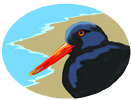
The scientific binomial for Pied-billed Grebe, Podilymbus podiceps, is Latin for “diving rump foot.” It’s a fitting description of the small bird’s legs and feet, which are attached toward the back of its body. This is a perfect arrange-ment for underwater diving, but it makes for awkward walking in the rare instances when the bird gets onto dry land.
Pied-billed refers to the dark ring that circles the middle of the bill in summer. The bill is chunky and chicken-like. The bird is a small, stocky grebe with a large head and dull brown feathers. It is 13 inches long. It appears to have no tail. There is a narrow white ring around a dark eye.
Although it is one of the most common grebes, it is often hidden among rushes on sluggish streams, ponds and marshes. The Pied-billed Grebe has been called “part bird, part subma-rine.” It can trap water in its feathers and deflate them so that it submerges straight down. Sometimes, only the eyes are visible above water. The thick bill is used to stab crayfish, amphibians and fish. It also forages on seeds and insects on the water’s surface.
Courtship is more vocal than visual. The male and female sing together. The nest, a floating platform anchored and hidden in reeds or rushes, is constructed with grass, reeds, and decayed plants—and often plastered with soft green pond scum. Both parents incubate the 5-7 bluish-white eggs for three weeks. The striped chicks typically leave the nest the first day after hatching. Chicks spend three weeks riding around on the parents’ backs, even back-riding when parents dive.
Pied-billed Grebe, April 2012, South Padre Island, Texas, Birding and Nature Center. B. Bowen Photo
